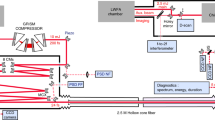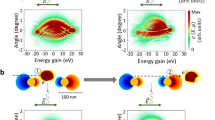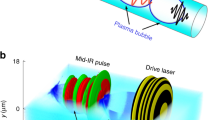Abstract
Subluminal and superluminal light pulses have attracted considerable attention in recent decades1,2,3,4, opening perspectives in telecommunications, optical storage and fundamental physics5. Usually achieved in matter, superluminal propagation has also been demonstrated in vacuum with quasi-Bessel beams6,7 or spatio-temporal couplings8,9. Although, in the first case, the propagation was diffraction free, but with hardly controllable pulse velocities and limited to moderate intensities, in the second, high tunability was achieved, but with substantially lengthened pulse durations. Here we report a new concept that extends these approaches to relativistic intensities and ultrashort pulses by mixing spatio-temporal couplings and quasi-Bessel beams to independently control the light velocity and intensity. When used to drive a laser-plasma accelerator10, this concept leads to a new regime that is dephasing free, where the electron beam energy gain increases by more than one order of magnitude.
This is a preview of subscription content, access via your institution
Access options
Access Nature and 54 other Nature Portfolio journals
Get Nature+, our best-value online-access subscription
$29.99 / 30 days
cancel any time
Subscribe to this journal
Receive 12 print issues and online access
$209.00 per year
only $17.42 per issue
Buy this article
- Purchase on Springer Link
- Instant access to full article PDF
Prices may be subject to local taxes which are calculated during checkout




Similar content being viewed by others
Data availability
The data that support the plots and findings of this paper are available from the corresponding author upon reasonable request.
References
Wang, L. J., Kuzmich, A. & Dogariu, A. Gain-assisted superluminal light propagation. Nature 406, 277–279 (2000).
Bigelow, M. S., Lepeshkin, N. N. & Boyd, R. W. Superluminal and slow light propagation in a room-temperature solid. Science 301, 200–203 (2003).
Stenner, M. D., Gauthier, D. J. & Neifeld, M. A. The speed of information in a ‘fast-light’ optical medium. Nature 425, 695–698 (2003).
Thévenaz, L. Slow and fast light in optical fibres. Nat. Photon. 2, 474–481 (2008).
Boyd, R. Slow and fast light: fundamentals and applications. J. Mod. Opt. 56, 1908–1915 (2009).
Alexeev, I., Kim, K. Y. & Milchberg, H. M. Measurement of the superluminal group velocity of an ultrashort Bessel beam pulse. Phys. Rev. Lett. 88, 073901 (2002).
Mugnai, D., Ranfagni, A. & Ruggeri, R. Observation of superluminal behaviors in wave propagation. Phys. Rev. Lett. 84, 4830–4833 (2000).
Sainte-Marie, A., Gobert, O. & Quéré, F. Controlling the velocity of ultrashort light pulses in vacuum through spatio-temporal couplings. Optica 4, 1298–1304 (2017).
Froula, D. H. et al. Spatiotemporal control of laser intensity. Nat. Photon. 12, 262–265 (2018).
Lu, W. et al. Generating multi-GeV electron bunches using single stage laser wakefield acceleration in a 3D nonlinear regime. Phys. Rev. ST Accel. Beams 10, 061301 (2007).
Tajima, T. & Dawson, J. M. Laser electron accelerator. Phys. Rev. Lett. 43, 267–270 (1979).
Malka, V. et al. Principles and applications of compact laser plasma accelerators. Nat. Phys. 4, 447–453 (2008).
Schroeder, C. B., Esarey, E., Geddes, C. G. R., Benedetti, C. & Leemans, W. P. Physics considerations for laser-plasma linear colliders. Phys. Rev. ST Accel. Beams 13, 101301 (2010).
Esarey, E., Schroeder, C. B. & Leemans, W. P. Physics of laser-driven plasma-based electron accelerators. Rev. Mod. Phys. 81, 1229–1285 (2009).
Steinke, S. et al. Multistage coupling of independent laser-plasma accelerators. Nature 530, 190–193 (2016).
Leemans, W. P. et al. GeV electron beams from a centimetre-scale accelerator. Nat. Phys. 2, 696–699 (2006).
Guillaume, E. et al. Electron rephasing in a laser-wakefield accelerator. Phys. Rev. Lett. 115, 155002 (2015).
Gonsalves, A. J. et al. Petawatt laser guiding and electron beam acceleration to 8 GeV in a laser-heated capillary discharge waveguide. Phys. Rev. Lett. 122, 084801 (2019).
Smartsev, S. et al. Axiparabola: a long-focal-depth, high-resolution mirror for broadband high-intensity lasers. Opt. Lett. 44, 3414–3417 (2019).
Davidson, N., Friesem, A. A. & Hasman, E. Holographic axilens: high resolution and long focal depth. Opt. Lett. 16, 523–525 (1991).
Hafizi, B., Esarey, E. & Sprangle, P. Laser-driven acceleration with Bessel beams. Phys. Rev. E 55, 3539–3545 (1997).
Kumar, S., Parola, A., Di Trapani, P. & Jedrkiewicz, O. Laser plasma wakefield acceleration gain enhancement by means of accelerating Bessel pulses. Appl. Phys. B 123, 185 (2017).
Sun, B., Salter, P. S. & Booth, M. J. Pulse front adaptive optics: a new method for control of ultrashort laser pulses. Opt. Express 23, 19348–19357 (2015).
Cui, Z. et al. Dynamic chromatic aberration pre-compensation scheme for ultrashort petawatt laser systems. Opt. Express 27, 16812–16822 (2019).
Guizar-Sicairos, M. & Gutiérrez-Vega, J. C. Computation of quasi-discrete Hankel transforms of integer order for propagating optical wave fields. J. Opt. Soc. Am. A 21, 53–58 (2004).
Schmid, K. et al. Density-transition based electron injector for laser driven wakefield accelerators. Phys. Rev. ST Accel. Beams 13, 091301 (2010).
Faure, J. et al. Controlled injection and acceleration of electrons in plasma wakefields by colliding laser pulses. Nature 444, 737–739 (2006).
Budriūnas, R. et al. 53-W average power CEP-stabilized OPCPA system delivering 5.5-TW few cycle pulses at 1-kHz repetition rate. Opt. Express 25, 5797–5806 (2017).
Rivas, D. E. et al. Next generation driver for attosecond and laser-plasma physics. Sci. Rep. 7, 5224 (2017).
Cartlidge, E. The light fantastic. Science 359, 382–385 (2018).
Vieira, J. & Mendonça, J. T. Nonlinear laser driven donut wakefields for positron and electron acceleration. Phys. Rev. Lett. 112, 215001 (2014).
Depresseux, A. et al. Table-top femtosecond soft X-ray laser by collisional ionization gating. Nat. Photon. 9, 817–821 (2015).
Phuoc, K. T. et al. All-optical Compton gamma-ray source. Nat. Photon. 6, 308–311 (2012).
Corde, S. et al. Femtosecond X-rays from laser-plasma accelerators. Rev. Mod. Phys. 85, 1–48 (2013).
Nie, Z. et al. Relativistic single-cycle tunable infrared pulses generated from a tailored plasma density structure. Nat. Photon. 12, 489–494 (2018).
Averchi, A. et al. Phase matching with pulsed Bessel beams for high-order harmonic generation. Phys. Rev. A 77, 021802 (2008).
Lifschitz, A. et al. Particle-in-cell modelling of laser-plasma interaction using Fourier decomposition. J. Comput. Phys. 228, 1803–1814 (2009).
Acknowledgements
We acknowledge support from the European Research Council through the project XFive (grant no. 339128), the French Agence Nationale de la Recherche (ANR) under reference ANR-19-TERC-0001-01 (project TGV), Gerry Schwartz and Heather Reisman, Israel Science Foundation, VATAT support and the French embassy in Israel through a Chateaubriand fellowship.
Author information
Authors and Affiliations
Contributions
C.C. and C.T. jointly proposed the concept of phase-locked acceleration, using axiparabola and spatio-temporal couplings. The idea was then developed by C.C. with advice from V.M. and C.T. C.C. and C.T. established the theoretical background, while C.C. and S.S. developed codes for optimizing and simulating axiparabola focus. Simulations were carried out by C.C. Finally, C.C. and C.T. wrote the manuscript with help from V.M. and S.S.
Corresponding author
Ethics declarations
Competing interests
C.T. and S.S. have filed a patent application (no. EP18305810.6) on axiparabola. The authors declare no other competing interests.
Additional information
Publisher’s note Springer Nature remains neutral with regard to jurisdictional claims in published maps and institutional affiliations.
Supplementary information
Supplementary Information
Supplementary discussion and Figs. 1 and 2.
Rights and permissions
About this article
Cite this article
Caizergues, C., Smartsev, S., Malka, V. et al. Phase-locked laser-wakefield electron acceleration. Nat. Photonics 14, 475–479 (2020). https://doi.org/10.1038/s41566-020-0657-2
Received:
Accepted:
Published:
Issue Date:
DOI: https://doi.org/10.1038/s41566-020-0657-2
This article is cited by
-
Coherence and superradiance from a plasma-based quasiparticle accelerator
Nature Photonics (2024)
-
Plasma interactions with bespoke laser pulses
Nature Photonics (2023)
-
Spatio-temporal couplings for controlling group velocity in longitudinally pumped seeded soft X-ray lasers
Nature Photonics (2023)
-
Dephasingless laser wakefield acceleration in the bubble regime
Scientific Reports (2023)
-
Reciprocating propagation of laser pulse intensity in free space
Communications Physics (2021)



